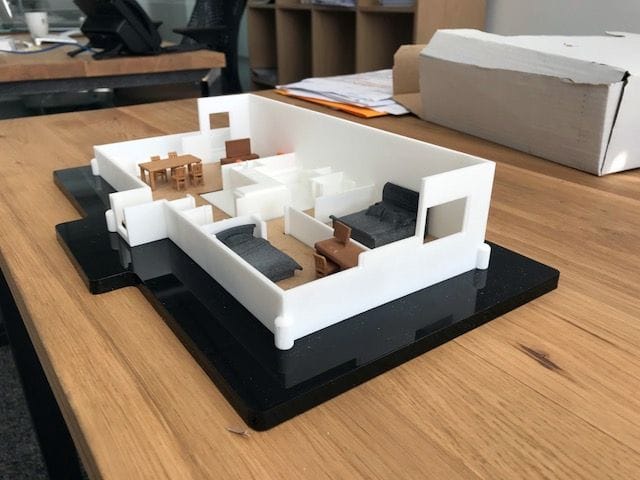![A 3D printed apartment [Source: Sculpteo]](https://fabbaloo.com/wp-content/uploads/2020/05/image-asset_img_5eb0a5501a990.jpg)
Sculpteo has made arrangements with a French property developer to 3D print selected apartments.
I know what you are thinking: this is yet another questionable construction 3D printing venture. But it’s not that at all: Sculpteo is 3D printing miniature replicas of apartments for new buyers.
The optional service is provided to buyers of apartments after the sale concludes, with the goal of providing the new homeowners an unusual method of becoming familiar with their apartment using 3D printing technology.
The apartments are replicated without a roof, enabling viewers to see inside the rooms, much like you would look at a blueprint from above. Their hope is that apartment owners would be able to contemplate furniture locations, artwork installations and more simply by being able to “visit” the apartment in physical 3D before they gain possession.
Real estate operations have long provided 3D views of properties, either through 3D viewing tools or more recently 360 degree virtual reality tech. While those approaches are now widely used, I’ve not heard of someone attempting the same with 3D printing until Sculpteo’s press release arrived.
Sculpteo has made arrangements with Paris-based property developer Valoptim, who seem to have both of their current projects involved in the Sculpteo program. Some 60 apartments are involved across the two properties.
![Front view of a 3D printed apartment replica [Source: Sculpteo]](https://fabbaloo.com/wp-content/uploads/2020/05/image-asset_img_5eb0a5508c180.jpg)
3D printing anything requires a suitable 3D model, and I suspect that’s where the fun part of this project lies. The property developer would no doubt have comprehensive blueprints describing the property, but blueprints are most definitely not 3D models. Somehow Sculpteo and Valoptim must translate these into 3D models, likely done manually.
The good news (for them) is that the design of the apartments likely have a number of duplicates, so that a smaller number of 3D models would need to be developed. In a much larger project, say a 40-story tower with 387 apartments, there would be many identical floor layouts.
Sculpteo is offering this service only with this particular developer at this time, probably because of the nature of the work required to develop the 3D models. It would be near impossible for, say, a real estate agent to request a 3D print of a residential home, because of the difficulties in preparing the 3D model. In some cases this would require measurements taken by professionals and 3D CAD experts to transform them into a proper 3D model.
Will the physical 3D view of the apartment be accepted? Will it become more popular than the 2D virtual 3D views so often found these days? I’m not sure, but I do know that some people have more affinity to physical representations than things they see on a screen. Interestingly, Valoptim does not mention this service on their advertising page for each property.
It is likely this venture is an experiment by both companies to determine interest levels. I have no idea if this will be adopted, but I do encourage the experiment: that is the only way new things are discovered.
![A future 3D printed memory for apartment-dwellers? [Source: Sculpteo]](https://fabbaloo.com/wp-content/uploads/2020/05/sculpteo-apartments-top_result_img_5eb0a550f1d47.jpg)
Meanwhile, after buyers use the print to help them organize their move-in operation and subsequent home set up, I suspect the 3D print will become an important memento they will keep and treasure for years to come.
Via Sculpteo











COBOD’s BOD2 construction 3D printer seems to be catching on as the company has made multiple sales of the new device.